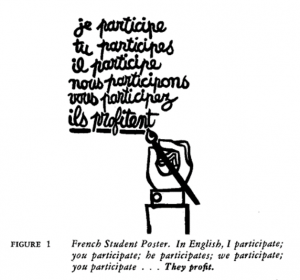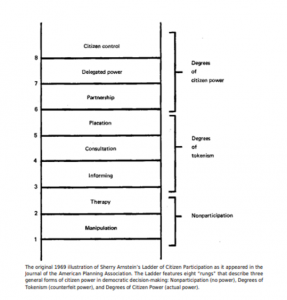Stronger provisions for public participation will give us a fighting chance at developing sustainably, while ensuring that people’s interests, particularly those of marginalised communities, are at the front and centre of the environmental decision-making process so that they are not forced to pay the opportunity cost of development.
——-
“KARAM Dev is worshipped in Bhadon (a month in the Hindu calendar), it is not mentioned in E.I.A. report, there is a place of Budha Dev 2 km from here, and residents here are blessed by him.… Our culture is not mentioned in a proper way”, said Balsai Kariam of Hariharpur village during a public hearing for an open cast coal mine. His village is set to be razed as part of the Parsa Coal Block in Chhattisgarh’s pristine Hasdeo Arand forests. Balsai made this statement during the public hearing in 2017 as part of the environmental clearance process for the mine, which has since been granted clearance.
“Trees in our area were cut so the temperature has risen to 40-45 degrees. People cannot sleep in the house, [because the] temperature is high. Trees planted here are not supportable [indigenous], you should ask the 70 people of the village about which tree should be planted here.”, he goes on. The mining project has been met with stiff resistance from marginalised adivasi communities, because their livelihood and cultural identity stand to be lost. These communities belong to the Gond and other tribes that are recognised tribal communities in the Fifth Schedule of the Constitution.
Public participation in the decision-making process is the cornerstone of democracy. As the world’s largest democracy, India should have a robust legal framework that provides ample room for participation in the decision-making process.
Given that development projects have far-reaching environmental and social impacts on marginalised communities, the law must provide for meaningful participation for them in deciding on these projects.
Meaningful public participation is especially important in the context of large development projects as they come at huge environmental, social and economic costs. The impact of these projects on the lives of those directly affected by them are often dramatic and long-lasting. It can mean the displacement of entire villages, loss of livelihood, loss of cultural identity, and health hazards from air, water, and noise pollution, impinging on their fundamental right to life. Given that development projects have far-reaching environmental and social impacts on marginalised communities, the law must provide for meaningful participation for them in deciding on these projects. But what are the existing frameworks, and are they adequate? What does “meaningful” participation really mean?
Process of public hearing under the EIA Notification, 2006
The Environment Impact Assessment Notification, 2006 (‘EIA’) lays down a regulatory framework for large development projects to minimise their impact on the environment. The notification establishes a four-step process consisting of screening, scoping, public hearing and appraisal before an expert committee. This committee then recommends or rejects the application for an environmental permit called the environmental clearance. If a project is recommended, the committee imposes a set of mitigation measures to minimise the environmental impacts of the project.
A critical part of this process is the public hearing, during which individuals, including those directly affected by a project as well as other citizens seek clarifications and express their concerns regarding a project.
The existing law requires the project proponent (the agency seeking to execute the project) to appoint an accredited EIA consultant to prepare an EIA report based on certain conditions (Terms of Reference) prescribed by the expert committee. Therefore, if one wants to build a hydroelectric power plant on a river, they are prescribed certain conditions based on which an EIA report is prepared. The purpose of the EIA report is to assess the potential environmental, social and economic implications of the project.
Once the report is prepared, the project proponents request for public hearings in every district in which the project is situated. Advertisements for the public hearing are placed in local newspapers, and the EIA report is then made available in the local language one month before the date of the public hearing. The idea is to give citizens ample time and opportunity to understand the implications of the project and raise any questions or concerns they may have. Thereafter, the District Magistrate or their representative and a representative of the State Pollution Control Board preside over the public hearing. The hearing is videographed and minutes are to be meticulously maintained. However, the proponent can exercise discretion in choosing which environmental concerns to respond to while preparing the final EIA report. This report is then sent to the committee for their deliberation before recommending or refusing an environmental permit to the project.
Over the years, the EIA Notification has undergone several amendments that have diluted the provisions for public hearings. For instance, one amendment passed in July 2017 exempts the expansion of coal mining projects from conducting a public hearing as part of the environmental clearance process if the expansion is up to 40 per cent of their original capacity. This means that an existing mine with a capacity of 100 MTP can apply for an environmental clearance for an additional 40 MTP. The environmental clearance process for the additional 40 MTP does not require the proponent to conduct a public hearing.
Over the years, the EIA Notification has undergone several amendments that have diluted the provisions for public hearings.
This relaxation in the law has not gone unnoticed by project proponents. For instance, South Eastern Coal Field Ltd. has applied for three expansions of their coal mines in Dipka in Chhattisgarh, each for an expansion of under 40 per cent of their original capacity, thus effectively circumventing the requirement for public hearings. This case is currently sub-judice before the Supreme Court of India for the legality of the amendment to the EIA notification.
This amendment seriously undermines the EIA notification in letter and spirit, and takes away the voice of communities that are directly affected by such projects.
Additionally, proposed amendments to the EIA Notification in 2020 also sought to exempt several project categories from the requirement of public hearings, and to reduce the time frame for citizens to peruse EIA reports before a public hearing, among other amendments. These proposed amendments saw huge citizen engagement and participation, as these dilutions would affect people’s ability to assert their opinions on development projects.
Also read: Draft EIA Notification 2020: Whose interests does it secure?
What more we need to do to improve public hearings?
A commonly accepted global practice is to engage with project-affected persons and other citizens from the early stages of the project. For instance, consulting project-affected persons when Terms of Reference (conditions for study of environmental impact) are issued to the project proponents, can add value to the EIA report. Not doing so creates a vacuum in the EIA reports as individuals who have a rich understanding of their lands are not involved in understanding the impact of a large project on their own lands. Therefore, public participation in its current form is reactionary, and does not engage with citizens from the get-go on the environmental permit process.


Credits: Sherry R. Arnstein, A Ladder Of Citizen Participation, Journal of the American Institute of Planners (1969)
Secondly, the project proponent can currently exercise discretion in responding to the questions and objections of the participants during the public hearing, which undermines the process. This is particularly the case when tribal communities are affected. Religious and cultural significance of the land do not make it into the EIA report, and come to light during the public hearing. However, these can easily be ignored by the project proponent as they are not bound to respond to every question or objection raised during the public hearing.
What stands out conspicuously in the existing provisions is that those impacted by the project do not have any power to affect the decision of the expert committee. Though they stand to lose the most, project-affected persons are not afforded a seat at the table while deciding on applications. The committee consists of a variety of experts including conservation biologists, environmental economists, risk assessment experts and sectoral experts. However, individuals who are directly affected by the project often belong to marginalised communities, and are not on this committee. They may have a lot to add to the appraisal of environmental clearance applications in terms of indigenous knowledge and cultural context, which is missing in the current composition of the committee.
Also read: Villagers of Jagatsinghpur struggle for 15 years against projects that threaten livelihood and land
What does “meaningful” participation mean?
While the definition of “meaningful” public participation is highly subjective, American social worker and public policy professional Sherry R. Arnstein’s paper, A Ladder of Citizen Participation, sheds some light on the shapes and forms that public participation can take. She broadly categorised public participation into three distinct types. Non-participation, she says, are governance models where the intention is not to engage with people, but to “cure” and “educate” them. Second, degrees of tokenism are governance models where citizens are heard, but lack the power to ensure that their inputs will be heeded by decision-makers. Finally, degrees of citizen power delegate power to citizens, or give them decision-making seats which empower them to affect the final outcome.


Credits: Sherry R. Arnstein, A Ladder Of Citizen Participation, Journal of the American Institute of Planners (1969).
India’s citizenry is vocal and proactive. We engage closely with decision-makers to help minimise the impacts of large development projects on the environment and our lives. This has become increasingly clear over the past years through our engagement in the public consultations for various amendments to environmental law. Large development projects with significant environmental impacts such as the expansion of the Mormugao Port in Goa have seen public consultations go on for eight days without a break, demonstrating the keenness of citizens to engage in the decision making process. Tribes in the Hasdeo Arand forests of Chhattisgarh are replicating the Chipko movement in protest against the proposed coal mines that have been granted clearance despite many concerns voiced by them and ignored during the public consultation process. This calls for reform in the existing legal framework for deeper public involvement in environmental decision-making.
What stands out conspicuously in the existing provisions is that those impacted by the project do not have any power to affect the decision of the expert committee. Though they stand to lose the most, project-affected persons are not afforded a seat at the table while deciding on applications.
Also read: Pushed to the brink, adivasis march against coal mine expansion in Hasdeo Arand, Chhattisgarh
India’s culture is rooted in nature, and we are naturally inclined to conserve what we have. Studies show how wild animals such as the elephant and tiger are revered, forests are the abode of our Gods, and using natural resources sustainably is at the heart of folklore in many parts of the country. Perhaps it is for this reason that we continue to have swathes of forest and wildlife despite a population of 1.3 billion people.
As we stare the climate crisis in the face, and as India faces more heat waves, it is becoming increasingly clear that citizenry will bear the brunt of unsustainable development. Stronger provisions for public participation will give us a fighting chance at developing sustainably, while ensuring that people’s interests, particularly those of marginalised communities, are at the front and centre of the environmental decision-making process so that they are not forced to pay the opportunity cost of development.


